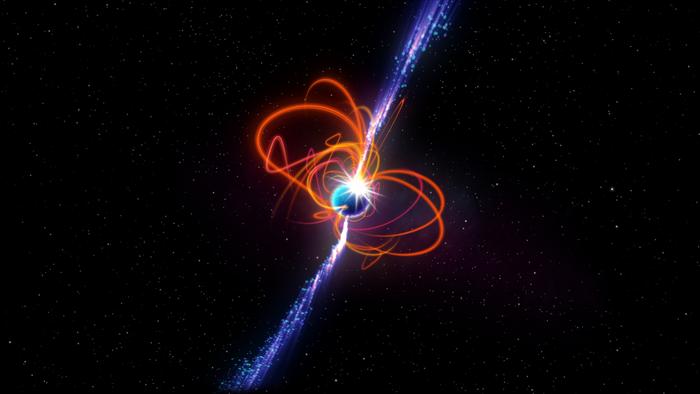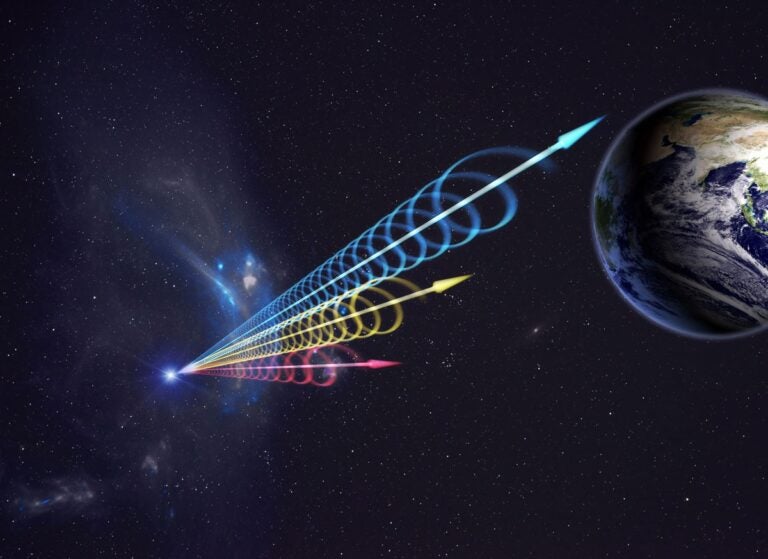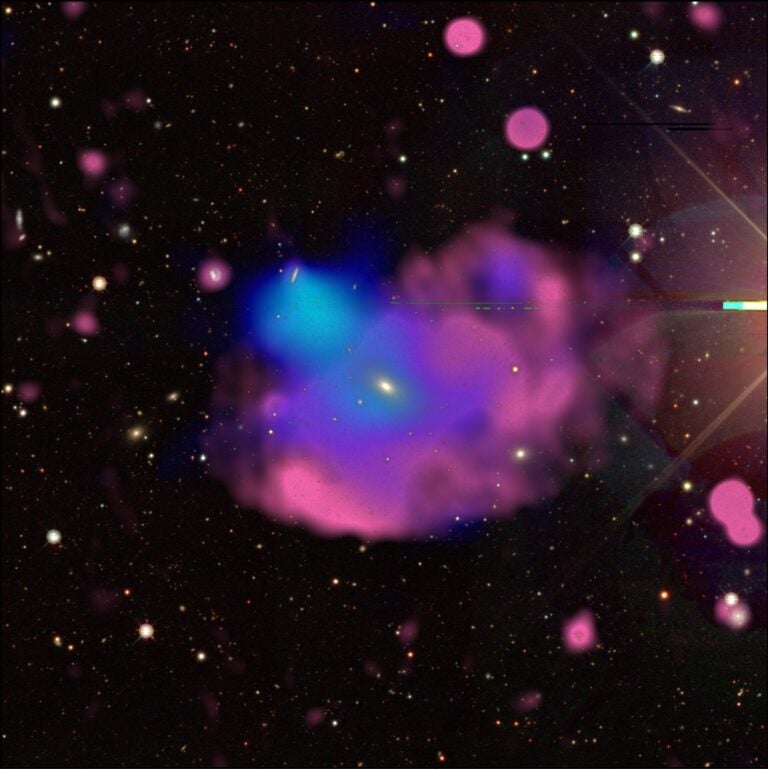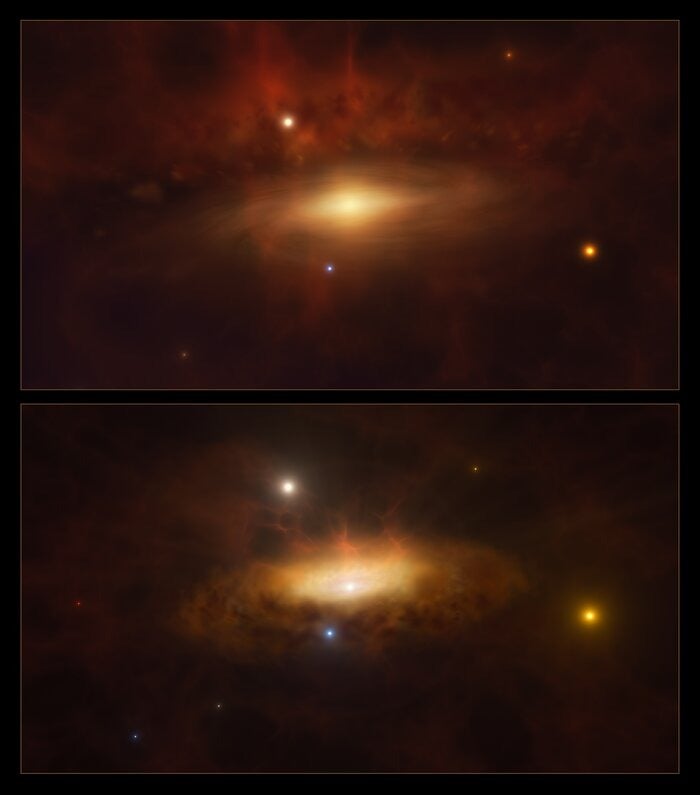
In 1988, radio telescopes picked up a transient signal from 15,000 light-years away within the constellation Scutum. But it remained unnoticed for three decades. Fast-forward to today: Astrophysicists have recently rediscovered the object to find that its source may be a magnetar — a rare type of neutron star with a powerful magnetic field that sends energy into space as it spins. Named GPM J1839-10, this star displays behavior unlike any previously noted.
All other known magnetars have speedy periods ranging from a few seconds to a few minutes. But the newly discovered object produces powerful five-minute-long bursts of radiation every 21 to 22 minutes, making it by far the most extended-period magnetar ever detected.
The discovery raises questions about the evolution and formation of magnetars and may help researchers understand mysterious occurrences like fast radio bursts, which are also thought to arise on magnetars. Details on the rediscovery of GPM J1839-10 were published this month in Nature.
“The universe still has the capacity to surprise us,” says Natasha Hurley-Walker, study author and astrophysicist at Curtin University in Perth, Australia.
The nature of neutron stars
Neutron stars are stellar remnants sometimes left behind after a massive star goes supernova at the end of its life. These stars have magnetic fields as powerful as a hundred trillion fridge magnets. Magnetars are a subclass of neutron stars with an extremely strong magnetic field. The magnetic fields of magnetars are a thousand times stronger than ordinary neutron stars, and a trillion times more magnetic than the Sun and Earth. Magnetars also sometimes give off short bursts of radiation.
There are only a dozen known magnetars, and astronomers still don’t know the specific conditions that create magnetars versus run-of-the-mill neutron stars. Magnetars typically emit radiation in high-energy X-rays, rather than lower-energy radio waves. “We think particularly magnetars are ridiculously magnetic, so much so that the magnetic field is all twisted and looped. And it stresses out the neutron star’s crust, which makes the crust quite hot and produces a lot of X-rays. So most magnetars were detected first with X-ray telescopes, not radio telescopes,” Hurley-Walker says.
Before finding GPM J1839-10, Hurley-Walker’s team noted a different mysterious radio object, dubbed GLEAM-X J162759.5–523504.3 (GLEAM-X J1627 for short), in 2018. With a period of 18 minutes, it appeared to be a magnetar with a so-called ultra-long period much greater than other known objects’. Astrophysicist Tyrone O’Doherty discovered the object while still an undergraduate working with Hurley-Walker. The team published a study in Nature in 2022 describing the strange source.
“A very small number of magnetars have been known to produce radio waves for a few weeks to months. We think the magnetic fields get into a situation where they can produce radio waves, but then they get out of it again. And so those radio magnetars, there’s like six or seven of them, were the best fit to our 18-minute source,” Hurley-Walker says.
Two of a kind
After discovering one ultra-long-period magnetar, Hurley-Walker set out to find more. Her team scanned the skies with the Murchison Widefield Array between July and September 2022 to look for objects similar to the previous magnetar.
The telescope, located in the outback of Western Australia, found GPM J1839-10, which emits flashes of energy that last up to five minutes — five times longer than GLEAM-X J1627, whose pulses last only about a minute. Other telescopes, including three CSIRO telescopes in Australia, the MeerKAT radio telescope in South Africa, the Gran Telescopio Canarias in Spain, and the XMM-Newton space telescope followed up to confirm its unique characteristics.
The team searched archives of the world’s radio telescopes to see if the possible magnetar was noted in past observations. They found that the object had been hiding in plain sight for decades, with records of GPM J1839-10 dating back to 1988 from the NRAO Very Large Array in New Mexico. Finding the object in archival data allowed the team to confirm its existence and see that it had been sending signals continuously for three decades. By contrast, GLEAM-X J1627’s radio signals lasted three months out of eight years of observations.
Perhaps most puzzling, when the team searched for GPM J1839-10 with an X-ray telescope, they found it was not producing any X-rays. But magnetars are “supposed to generate bright X-ray bursts,” says Hurley-Walker, “either just before or with the radio pulses.” So, she says, GPM J1839-10’s lack of X-ray emission coupled with its long period make it a little harder to believe it might be a magnetar.
Problem child
Not all neutron stars produce radio waves. Some are found below what’s known as the “death line,” where a neutron star’s magnetic field becomes too weak and its rotation is too slow to generate radio emission. And, given its 22-minute period, GPM J1839-10 should be spinning too slowly to produce radio waves — yet it’s clearly doing so.
“This is sort of disobeying how we thought that neutron stars were able to produce radio emission, which is challenging for both pulsars and magnetars,” Hurley-Walker says.
Although that pokes a hole into any suspicions that this object might be a magnetar, it could instead simply mean experts need to change their thinking about the behavior of neutron stars and magnetic fields in extreme environments. If GPM J1839-10 is indeed a magnetar, Hurley-Walker’s team suspects it’s a special type of magnetar, whose emission is powered by a twisted magnetic field.
But there is another explanation. Instead of a neutron star, GPM J1839-10 could be a strange, highly magnetic white dwarf. White dwarfs, which are the leftover cores of Sun-like stars that don’t explode, have less intense magnetic fields than neutron stars (and especially magnetars). White dwarfs are larger than neutron stars, and thus spin more slowly, which could explain GPM J1839-10’s long period.
Or, of course, there’s a third scenario: GPM J1839-10 could be an entirely new object never before seen in the skies.
The answer is still a toss-up. Hurley-Walker says she has polled world experts in transient radio astronomy, asking who thought it was a neutron star, white dwarf, or something else. “The room was just split,” she says. “Not just observers but also theorists and people were like, this just breaks all the rules. It’s why it’s such an exciting result.”
Whatever they may be, as more objects like GPM J1839-10 and GLEAM-X J1627 are found, they suggest that ultra-long-period radio sources are not as rare as once thought. For now, Hurley-Walker’s team plans on further observing GPM J1839-10 and conducting more surveys to learn more about its behavior.
“I’m looking forward to all the theory papers that come out trying to explain the object and forward to all the observers, trying to find more. Hopefully, we’ll solve the mystery together,” says Hurley-Walker.









